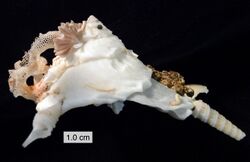Biology:Xenophoridae
| Xenophoridae | |
|---|---|

| |
| Xenophora pallidula, a carrier shell | |
| Scientific classification | |
| Domain: | Eukaryota |
| Kingdom: | Animalia |
| Phylum: | Mollusca |
| Class: | Gastropoda |
| Subclass: | Caenogastropoda |
| Order: | Littorinimorpha |
| Superfamily: | Xenophoroidea |
| Family: | Xenophoridae Troschel, 1852 (1840) |
| Genera | |
|
See text | |
| Synonyms | |
| |
Xenophoridae, commonly called carrier shells, is a family of medium-sized to large sea snails, marine gastropod mollusks in the clade Littorinimorpha.
Distribution
The Xenophorids live on sand and mud bottoms of the continental shelves and the continental slopes of the subtropical and tropical seas and range from very shallow water to depths of more than 1,400 meters.[1]
Shell description
Xenophorids are unusual in that in many of the species the animal cements small stones or shells to the edge of the shell as it grows, thus the shells of those species are sometimes humorously referred to as "shell-collecting shells". The genus name Xenophora comes from two ancient Greek words and means "bearing (or carrying) foreigners". The shells are small to rather large (diameter of base without attachments 19–160 mm; height of shell 21–100 mm), depressed to conical, with narrow to wide, simple to spinose peripheral edge or flange separating spire from base. Aperture large, base broad, rather flattened, often umbilicate. Periostracum very thin or wanting. Protoconch depressed-conical, multispiral (in one species paucispiral). Teleoconch usually with foreign objects attached in spiral series to peripheral flange and, sometimes, remainder of dorsum, at least on early whorls. Operculum horny, yellowish to brown, nucleus lateral, with simple growth lamellae, sometimes with conspicuous radial striae or hollow radial ribs.[1]
Classification
Xenophoridae belongs to the superfamily Stromboidea, which also includes the true conchs (Strombidae).[2] It had previously been placed in a monotypic superfamily, Xenophoroidea,[3] but placement in Stromboidea is supported by behavioral,[4] anatomical,[5] and genetic data.[6] Within Stromboidea, Xenophoridae appears to be most closely related to Aporrhaidae and Struthiolariidae.[6]
According to the taxonomy of the Gastropoda by Bouchet & Rocroi (2005) the family Xenophoridae has no subfamilies.
Genera
Genera within the family Xenophoridae include:[1][7]
- † Acanthoxenophora Perrilliat & Vega, 2001
- Aspidophoreas Nappo, Bini & Santucci, 2022
- Onustus Swainson, 1840 - synonyms: Trochotugurium Sacco, 1896; Tugurium Fischer in Kiener, 1879[8]
- Ponderiana Nappo, Bini & Santucci, 2022
- Stellaria Möller, 1832 - synonym: Haliphoebus Fischer in Kiener, 1879; Xenophora (Stellaria) Schmidt, 1832[9]
- Xenophora Fischer von Waldheim, 1807[10] - type genus
Behavior
Like other stromboids, xenophorids move in a "leaping" manner.[4] Xenophora conchyliophora has been found to move an average of 233.5 cm per day, with its speed during short-duration "sprints" averaging 1.44 cm per minute and reaching a maximum speed of 5.5 cm per minute.[11]
Xenophorids incorporate shells, coral, and other objects into their shells as they grow. Several different hypotheses have been proposed to explain this behavior.[12]
References
- ↑ 1.0 1.1 1.2 Kreipl, K. & Alf, A. (1999): Recent Xenophoridae. 148 pp. incl. 28 color plts. ConchBooks, Hackenheim, ISBN:3-925919-26-0.
- ↑ "Xenophoridae Troschel, 1852 [1840"]. Molluscabase. https://molluscabase.org/aphia.php?p=taxdetails&id=23144.
- ↑ Bouchet, Philippe; Rocroi, Jean-Pierre; Hausdorf, Bernhard; Kaim, Andrzej; Kano, Yasunori; Nützel, Alexander; Parkhaev, Pavel; Schrödl, Michael et al. (2017). "Revised Classification, Nomenclator and Typification of Gastropod and Monoplacophoran Families". Malacologia 61 (1-2): 1–526. doi:10.4002/040.061.0201. ISSN 0076-2997. http://www.bioone.org/doi/10.4002/040.061.0201.
- ↑ 4.0 4.1 Berg, Carl J. (1974). "A comparative ethological study of strombid gastropods". Behaviour 51 (3-4): 274–321. doi:10.1163/156853974X00219. ISSN 0005-7959.
- ↑ Simone, Luiz Ricardo L. (2005-11-28). "Comparative morphological study of representatives of the three families of Stromboidea and the Xenophoroidea (Mollusca, Caenogastropoda), with an assessment of their phylogeny". Arquivos de Zoologia 37 (2): 141. doi:10.11606/issn.2176-7793.v37i2p141-267. ISSN 0066-7870. http://www.revistas.usp.br/azmz/article/view/12023.
- ↑ 6.0 6.1 Irwin, Alison R.; Strong, Ellen E.; Kano, Yasunori; Harper, Elizabeth M.; Williams, Suzanne T. (2021). "Eight new mitogenomes clarify the phylogenetic relationships of Stromboidea within the caenogastropod phylogenetic framework". Molecular Phylogenetics and Evolution 158: 107081. doi:10.1016/j.ympev.2021.107081. ISSN 10557903.
- ↑ "Xenophoridae". Integrated Taxonomic Information System. https://www.itis.gov/servlet/SingleRpt/SingleRpt?search_topic=TSN&search_value=72682.
- ↑ WoRMS (2010). Onustus Swainson, 1840. Accessed through: World Register of Marine Species at http://www.marinespecies.org/aphia.php?p=taxdetails&id=468030 on 2010-08-07
- ↑ WoRMS (2010). on 2010-08-07 Stellaria Möller, 1832. Accessed through: World Register of Marine Species
- ↑ WoRMS (2010). Xenophora Fischer von Waldheim, 1807. In: Bouchet, P.; Gofas, S.; Rosenberg, G. (2010) World Marine Mollusca database. on 2010-08-07 Accessed through: World Register of Marine Species
- ↑ Berg, Carl J. (1975). "Behavior and ecology of conch (Superfamily Strombacea) on a deep subtidal algal plain". Bulletin of Marine Science 25 (3): 307–317.
- ↑ Feinstein, Noah; Cairns, Stephen D. (1998). "Learning from the collector: a survey of azooxanthellate corals affixed by Xenophora (Gastropoda: Xenophoridae), with an analysis and discussion of attachment patterns". The Nautilus 112 (3): 73–83.
External links
- Family: Xenophoridae (Carrier Shells)
- Troschel, F. H. (1852). Bericht über die Leistungen im Gebiete in der Naturgeschichte der Mollusken während des Jahres 1851. Archiv für Naturgeschichte. 18(2): 257-307
- Gray, J. E. (1840). Shells of molluscous animals, pp. 105-152. in: Synopsis of the contents of the British Museum. ed. 42. G. Woodfall. London. 370 pp.
- Adams, H. & Adams, A. (1853-1858). The genera of Recent Mollusca; arranged according to their organization. London, van Voorst. Vol. 1: xl + 484 pp.; vol. 2: 661 pp.; vol. 3: 138 pls.
- Ladd, H.S. (1977). Cenozoic fossil mollusks from western Pacific islands; Gastropods (Eratoidae through Harpidae). U.S. Geological Survey Professional Paper. 533: i–iv, 1–84, pls 1–23
 This article incorporates text from this source, which is in the public domain.
This article incorporates text from this source, which is in the public domain. - Ponder W.F. (1983). A revision of the Recent Xenophoridae of the World and of the Australian Fossil Species (Mollusca : Gastropoda). Memoir 17. The Australian Museum Sydney, Australia
Wikidata ☰ Q4053381 entry
 |


